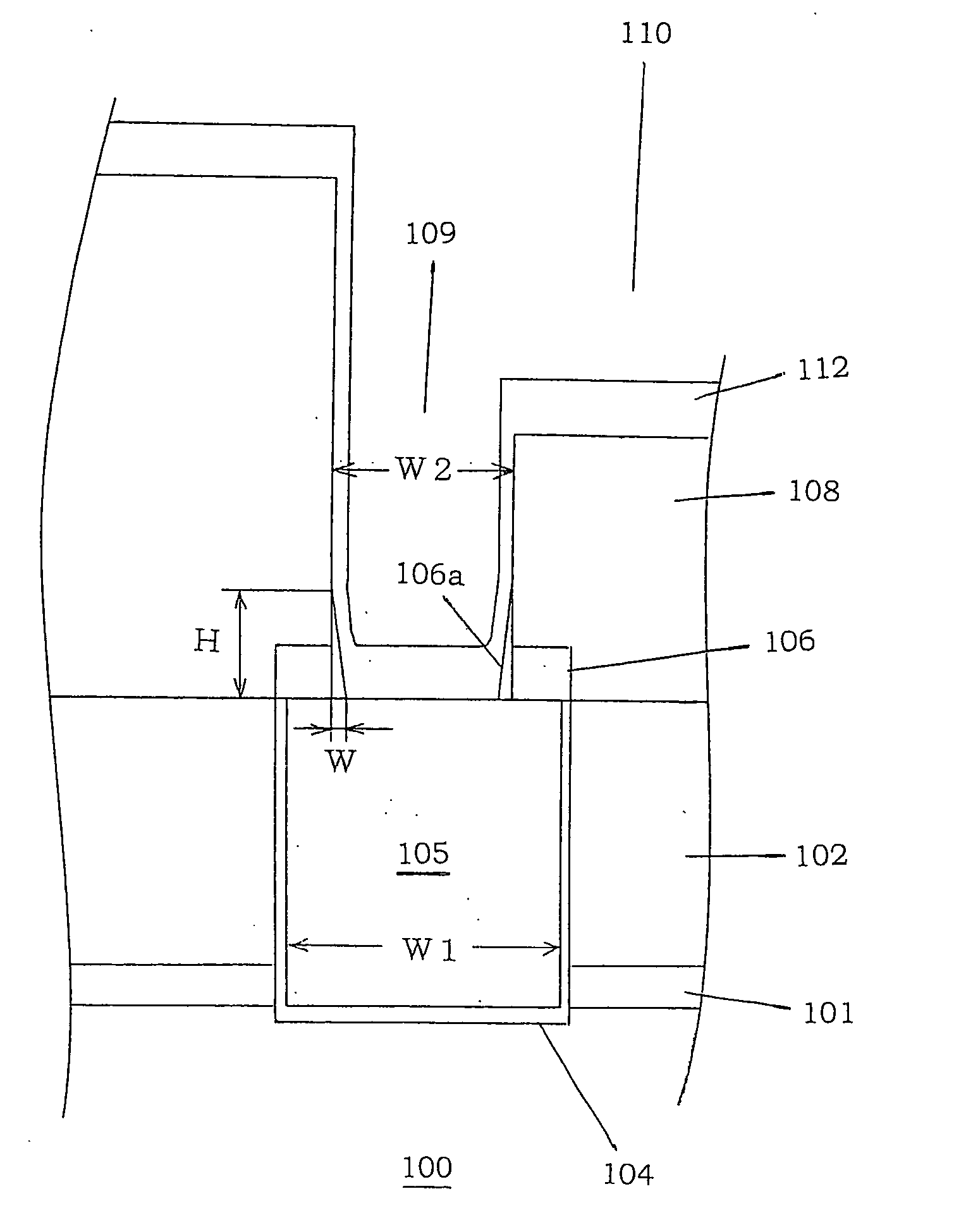Wire structure and forming method of the same
- Summary
- Abstract
- Description
- Claims
- Application Information
AI Technical Summary
Benefits of technology
Problems solved by technology
Method used
Image
Examples
first embodiment
[0050]FIGS. 1 and 2 respectively show cross sectional diagrams each illustrating a portion of the wire structure during the manufacturing process according to a first embodiment of the present invention.
[0051] The forming method for a wire structure according to this first embodiment is concretely described in the following. First, an etching stopping film 101 made of Si3N4 is formed on top of a semiconductor substrate 100, and furthermore, a first insulating layer 102 is formed so as to have a film thickness of 200 nm to 400 nm. The first insulating layer 102 is dry etched using a photoresist film (not shown) as a mask so that a plurality of first trenches (lower layer trenches) 103 are formed (see FIG. 1(a)).
[0052] Next, a first diffusion preventing film 104 made of TaN is formed so as to cover the surface of the first insulating layer 102 and the inner surface of the respective first trenches 103, and have a film thickness of 10 nm to 20 nm. A copper seed film is formed on the ...
second embodiment
[0065]FIGS. 4 and 5 respectively show cross sectional diagrams each illustrating a portion of the wire structure during the manufacturing process according to a second embodiment of the present invention. Here, mainly points of the second embodiment which are different from the first embodiment are described in detail.
[0066] In the second embodiment, as shown in FIG. 4(a), a copper film 205a having a film thickness of 100 nm to 150 nm is formed on a first insulating layer 202 with a first diffusion preventing film (TaN) 204 having a film thickness of 10 nm to 20 nm in between, in accordance with the same method as that in the first embodiment, so as to completely fill in the first trenches. Next, as shown in FIG. 4(b), the copper film 205a and the first diffusion preventing film 204 on the first insulating layer 202 are removed in accordance with a CMP method where the polishing rate of the metal film is higher than that of the first insulating layer 202, so that first wires 205 ar...
third embodiment
[0073]FIGS. 6 and 7 respectively show cross sectional diagrams each illustrating a portion of the wire structure during the manufacturing process according to a third embodiment of the present invention.
[0074] In this third embodiment, the second and third layers, which are insulating layers, are formed so as to have a single Damascene wire structure. First, as shown in FIGS. 6(a) to 6(c), a first interlayer diffusion preventing film 306 made of TaN having a film thickness of approximately 10 nm to 50 nm is formed on a first wires 305 and a first insulating layer 302 in accordance with a sputtering method, which is the same method as in the first embodiment. The first interlayer diffusion preventing film 306 on the first insulating layer 302 is removed through etching using a resist mask 307 while leaving the first interlayer diffusion preventing film 306 on the first wires 305, and after that, the resist mask 307 is removed. Here, in FIG. 6(a), a numeric symbol 300 indicates a sem...
PUM
 Login to View More
Login to View More Abstract
Description
Claims
Application Information
 Login to View More
Login to View More - R&D
- Intellectual Property
- Life Sciences
- Materials
- Tech Scout
- Unparalleled Data Quality
- Higher Quality Content
- 60% Fewer Hallucinations
Browse by: Latest US Patents, China's latest patents, Technical Efficacy Thesaurus, Application Domain, Technology Topic, Popular Technical Reports.
© 2025 PatSnap. All rights reserved.Legal|Privacy policy|Modern Slavery Act Transparency Statement|Sitemap|About US| Contact US: help@patsnap.com



